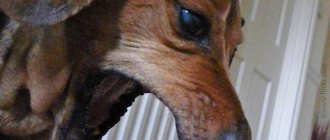Unpretentious, curious, brave and devoted to the tip of the tail to the owner - all this is about the Chihuahua.
The charming dogs owe the name of their breed to the state of the same name in Mexico - it is believed that their homeland is there. There is a lot of evidence of this, especially in art.
Chihuahuas live a long time and practically do not get sick; they do not have to visit the veterinarian often.
However, there are important points that both those who are planning to have a pet and those who already have a dog of this breed in their home need to know.
We will talk about one such moment in our article, namely, why a Chihuahua grunts and snores.
Why does the dog grunt?
The main feature of the Chihuahua breed that is important to know about is its very short and pointed muzzle. Because of this structure, the dog has “reverse breathing” - an irritated palate provokes a spasm of the pharynx. This syndrome is also called “reverse sneezing.”
Many owners are seriously frightened by such manifestations of their pets - the animal can suddenly strongly stretch its neck, tense its chest muscles, and strongly arch its back. At the same time, the Chihuahua convulsively gasps for air, wheezes and makes loud grunting sounds, as if he is suffocating.
Don't be afraid when your pet grunts through his nose - this is how he tries to restrain himself in order to start breathing normally again. Some owners are touched by pets that make such funny sounds.
IMPORTANT!
You have to be on your guard - there are times when Chihuahuas begin to choke. It’s better to prevent trouble - monitor your pet’s health so that he doesn’t get sick, overexcited or sad, because all these reasons can provoke strong grunting.
Cough when a foreign body enters the respiratory tract
As a rule, if a dog chokes or swallows something extra, it copes with the situation on its own by coughing up. At such a moment, the cough begins suddenly, sharply, accompanied by corresponding movements of the neck and head, and a characteristic posture.
There may be another situation: the animal choked on a sharp bone, an object that, due to its shape or size, got caught in the mucous membrane. Then the following symptoms may appear:
- cough in fits and starts, prolonged, debilitating;
- during the cough reflex, the pet tries to push the foreign body out of the throat;
- wheezing;
- difficulty breathing;
- foam from nostrils;
- cough with blood, foam;
- refusal to drink and eat.
You cannot hope that the dog will cope on its own. Trying to pull out (or even see) what got into her throat is almost impossible without special tools. The animal needs to be taken to the clinic urgently. Delay threatens the development of emphysema, inflammatory processes in the bronchi, lungs, pleura and other complications.
Main reasons
When dogs grunt, they try to clear their airways. There are many reasons why this can happen - the reins are too tight, strong odors, powder getting into the nose.
It happens that a pet sneezes when it is very happy or eats food faster than usual. Another reason is problems with the sky. Your pet may have a cleft or a soft or drooping palate.
There are more serious reasons - for example, serious health problems . It could be a tick, various infections, polyps in the mouth. Therefore, if your pet grunts with enviable regularity, then you should definitely show it to the veterinarian. Without timely assistance, the dog may get worse.
A heart attack is the most dangerous cause of grunting. The first thing that is important to pay attention to is the language. If he turns blue, the dog should be taken to the vet immediately.
Another problem that can cause a baby to “grunt” is obesity, so you need to monitor your Chihuahua’s diet and prevent the dog from overeating.
This problem is discussed in many veterinary forums. Doctors recommend carefully monitoring your pet’s condition, because dogs cannot talk about what’s bothering them. Therefore, all hope lies in the owner, who will sound the alarm in time, will not let the situation take its course, and will show the Chihuahua to a specialist.
Read here what foods you can feed your Chihuahua.
It is not always possible to independently diagnose the cause of grunting, so it is better to entrust the examination to a professional.
NOTE!
As veterinarians note, a dog that frequently grunts may have an inflammatory process, severe allergies, or collapse of the trachea.
Bordetella Bronchiseptica – infection and protection
Bordetella bronchiseptica (B. bronchiseptica) is a gram-negative, aerobic coccobacterium. This bacterium is the main etiological factor in infectious tracheobronchitis (ITB) or kennel cough. However, Bordetella bronchiseptica cannot be considered a synonym for ITB, since in addition to this bacterium, infectious tracheobronchitis is also caused by a number of other bacteria (chlamydia, mycoplasma) in combination with viruses (parainfluenza, adenovirus, canine distemper). Veterinary clinics Veterinary doctors St. Petersburg Veterinary drugs Vitamins and dietary supplements Bordetellosis in dogs in combination with one of the above viruses leads to the most severe consequences of tracheobronchitis, up to the development of pneumonia in puppies and young animals. The main route of infection with B. bronchiseptica is airborne from sick dogs, but infection is possible through household items of dogs and their owners (tableware, animal bowls, clothing, muzzle, leash, etc.), as well as from cats. Despite more than twenty years of use of parenteral vaccines to immunize animals against ITB, outbreaks of the disease have been reported throughout the world. This indicates insufficient protection during parenteral immunization of dogs. On the other hand, B. bronchiseptica is not a highly specific pathogen and can be transmitted not only from one dog to another, but also from cats to dogs and, vice versa, causing disease.
Pathogenesis
Most of the information about the pathogenesis of B. bronchiseptica is obtained from infections of dogs with this bacterium. In addition to dogs, infection has been reported in pigs, laboratory animals (rats, hamsters, guinea pigs, rabbits and mice), cats, and also in humans. The bacterium infects the tissues of the respiratory tract, but it is also found in the upper gastrointestinal tract. B. bronchiseptica, penetrating the respiratory tract, colonizes on the surface of cells of the trachea and bronchi, causing stasis of the epithelial cilia by producing exo- and endotoxins. These toxins destroy the protective effect of the cellular apparatus, reducing cell secretion, disrupting phagocytosis and suppressing the cellular and humoral immune response. This process opens the gate for respiratory viruses and bacteria to enter and become infected. Additionally, B. bronchiseptica has the unique ability to penetrate the cells of the tricea and bronchi to avoid antibacterial drugs and the immune system. The mechanism of penetration has not yet been studied; it is only known that the bacterium can remain viable in a cell for up to several months. This ability of the bacterium can lead to a long course of infectious tracheobronchitis.
Clinical signs
Outbreaks of the disease do not have a seasonality. Clinical signs of infectious tracheobronchitis in most cases are limited to a dry and loud cough. The owner may mistake coughing up mucoid or mucoid-purulent mucus for an act of vomiting. Anorexia, fever, lethargy and pneumonia are observed rarely in ITB and mainly in puppies and dogs of the first year of life. The first clinical signs begin 3-10 days after infection. Most clinical cases can be associated with visiting exhibitions, veterinary clinics, or interacting with sick dogs and cats.
Diagnosis
The diagnosis of ITB is made based on vaccination history, clinical signs of the disease and medical history, as described above. Chest X-ray and hematology are not diagnostic procedures. A quick and effective response to antibiotics confirms the diagnosis.
Recommendations for the treatment of ITB caused by B. bronchiseptica
Treatment of B. bronchiseptica is reduced to the use of antibacterial drugs, possibly simultaneous use with drugs to prevent cough. Antibacterial drugs. Most dogs with infectious tracheobronchitis do not require antibiotics. In most cases, antibiotics are prescribed empirically to prevent the development of secondary infections. Whether pneumonia develops in dogs with infectious tracheobronchitis is not completely clear. Glucocorticoids. Short-term use of glucocorticoids concomitantly with antibacterial drugs is safe and effective in dogs without concomitant diseases. Since some antibiotics have a bacteriostatic effect, the administration of glucocorticoids for a period of more than 5 days is not recommended, and antibacterial therapy was continued for at least another 5-7 days after the use of glucocorticoids. Antitussives or their combination with bronchodilators are recommended as symptomatic treatment of infectious tracheobronchitis, if there is no suspicion of pneumonia.
Vaccination
There are currently a number of commercial vaccines available for active immunization of dogs against B. bronchiseptica. All vaccines can be divided into two groups: parenteral and intranasal. Both parenteral and intranasal vaccines significantly reduce the severity of clinical manifestations of ITB. However, parenteral vaccines can lead to allergic reactions, which are associated with the degree of purification of the vaccine from bacterial lipopolysaccharides. This problem is not present in the production of intranasal vaccines. Also, when administering the vaccine parenterally, an important point is the high titer of maternal antibodies, which eliminate the vaccine before the age of eight weeks and partially at the age of 8-12 weeks. Therefore, parenteral administration of vaccines is required twice. Intranasal vaccines must be administered twice if maternal antibodies are present and once for puppies over 8 weeks of age. In addition, only intranasal vaccines are safe for use in pregnant dogs. Intranasal vaccines provide a faster and better immune response than parenteral vaccines, which combines both general immunity and the production of large amounts of secretory antibodies or immunoglobulin A (IgA). This quality of intranasal vaccines is of great importance during an outbreak of infectious tracheobranchitis or on the eve of exhibitions. After the administration of intranasal vaccines, minor serous discharge from the eyes and nasal cavity of dogs, as well as sneezing, is acceptable for up to three days. Material provided by Intervet LLC MSD Animal Health Address of Intervet LLC: Moscow, st. Smolnaya, 24 D, Meridian Commercial Tower
What to do?
One simple but proven method will probably help. The dog needs to be placed on the floor or table, the main thing is that the surface should be flat. Gently massage your back in a clockwise direction. It is important to lightly support the Chihuahua under the tummy. You can lightly run your hand over your pet's throat to help him swallow.
Another option is to close your nostrils with your fingers. The dog will inhale air through its mouth and swallow saliva, as it will not be able to breathe through its nose.
Has your pet started to choke? First, check to see if your pet is choking—there may be something sticking out of her mouth. Then the foreign object must be carefully removed.
There is another way. Rub the bridge of your pet's nose, press on the wings of the nose, and then press on the root of the tongue. The dog may resist and start barking - this will also help open the way for oxygen.
Chihuahua owners recommend giving dogs antihistamines if they grunt frequently - this reduces the intensity of attacks. However, it is better not to self-medicate, but to consult a veterinarian. The specialist will tell you which product is best for your pet and recommend the correct dose.
Treatment
- Fighting the pathogen.
Since the disease is caused by bacteria, bordetellosis must be treated with antibiotics. Bordetella bronchiseptica is resistant to many drugs. Synulox (amoxicillin), popular among veterinarians, turns out to be useless. If a diagnosis of “infectious tracheobronchitis” is established, the cat is prescribed other broad-spectrum antibiotics - Doxycycline or Baytril. They are used once a day, carefully calculating the dose based on body weight (10 mg/kg). The course cannot be interrupted, even if the signs of the disease cease - it must be at least 14 days.
- Maintenance therapy.
Depending on how severe the infection is, the cat needs support, sometimes even hospital treatment. The owner must regularly clean the eyes and nose of secretions, preventing the formation of crusts. If the discharge is purulent, eye drops with an antibiotic (Floxal, Tobrex) are indicated.
The pet is kept warm. The food should be as appetizing and easily digestible as possible, since animals often refuse to eat and drink. You can use industrial canned food - Royal Canin Recovery and others.
If there are signs of dehydration, droppers with nutrient solutions are given, vitamin preparations and amino acid mixtures are used.
Why does my pet snore?
Chihuahuas not only grunt, but also snore and sometimes do it so loudly that they do not allow their owners to fall asleep.
Snoring itself does not affect the animal’s life in any way, but it can be a signal to the owner that the pet may have a serious illness. Owners of dogs of some breeds may be seriously alarmed. But in a number of pets, snoring is associated with physiology, just like grunting - its cause is a shortened muzzle.
Is there any point in worrying if a Chihuahua snores not from time to time, but regularly? If your pet snores only at night while sleeping, then you should not be upset, but if strange sounds begin to appear suddenly during the day and do not go away for a long time, then this is a reason to sound the alarm.
There can be many reasons for snoring. One of the most popular is improper dog nutrition. Your pet will likely need a special diet.
It is worth taking measurements of the humidity at home to understand whether such conditions are suitable for the dog - perhaps its mucous membranes dry out during sleep.
IMPORTANT!
If a pet snores heavily, owners of dogs of this breed recommend taking their Chihauhua to a veterinarian so that he can understand the reasons and rule out serious diseases.
The main types of cough in dogs and how to treat cough in dogs
Cough caused by viral diseases
Dogs can infect each other with infections. Viral tracheobronchitis or “kennel cough” is one of these diseases. From the second name it is clear that this disease often affects animals that live crowded in a nursery and become infected from each other.
The main causative agents of viral tracheobronchitis are:
- mycoplasma;
- Bordetella bronchiseptic;
- pseudomonas;
- Klebsiella pneumonia.
When infected with tracheobronchitis, the dog develops a cough as if it was choking. It is deep, dry, very frequent and greatly exhausts the dog. Some animals sneeze, snort, gag, regurgitate white foam, and sometimes vomit. At the same time, the dog eats poorly, becomes lethargic, and if you look into his throat you can see enlarged tonsils.
From the moment of contact with a sick animal to the appearance of the dog’s first cough, it takes from two days to two weeks, this depends on the immunity of the infected dog. All breeds of dogs and animals of any age are susceptible to the disease.
Tracheobronchitis usually occurs in a mild form and the dog recovers in two to three weeks, but in some cases complications such as pneumonia can occur. If the dog has been coughing for a long time and the cough becomes more severe, shortness of breath appears, and mucus and blood are coughed up, then an urgent trip to the veterinarian is necessary to prevent serious consequences.
In breeds that have a narrowed trachea, the cough can last more than three weeks, so in this case it is better to play it safe and consult a veterinarian to rule out a complication.
How to treat a dog's cough with tracheobronchitis?
If the course of the disease is mild enough, then you need to give the dog’s immunity a chance to cope with the infection on its own. If the animal is not feeling well, it is necessary to use not only antitussive medications to alleviate the condition, but also add expectorants to prevent the stagnation of mucus in the bronchi. In severe cases, antibiotic therapy is used.
What else should you do if your dog is coughing as if he is choking? The animal needs a lot of rest, its diet should be varied and enriched with vitamins. It is advisable that the air in the house where the sick dog is located is warm and humidified.
Preventive actions
For prevention, contact between your pet and infected dogs should be prevented.
An intranasal vaccine facilitates the rapid formation of immunity to the virus in animals. First of all, it is relevant for puppies. It is advisable to vaccinate in a timely manner. The maximum effect is achieved 4–5 days after the procedure.
1 vaccination must be intranasal. The next 2 times the medicine is administered subcutaneously.
After this, the dog needs to be vaccinated every 12 months. This helps maintain the required level of immunity.
It is also important to prevent your dog from coming into contact with infected animals.
Many people have heard about a terrible human disease called whooping cough. Vaccinations against this infection are given to children before they are one year old, since even with the availability of modern antibiotics, the disease remains extremely dangerous. Our furry pets can also have whooping cough, a respiratory tract infection caused by a bacterium of the genus Bordetella. Only in humans the disease is caused by Bordetella pertussis, and in cats and dogs - by Bordetella bronchiseptica.
Possible consequences
The most severe complication of infectious laryngotracheobronchitis is pneumonia. It develops in the absence of timely treatment for kennel cough, most often in puppies, older dogs and dogs with weak immune systems. Advanced pneumonia, in turn, leads to the death of the animal and to a significant lag in the development and growth of young individuals.
The disease is often complicated by conjunctivitis, anorexia and pharyngitis. Pets also develop small hemorrhages on the skin in the neck area. Against the background of weakened immunity, a secondary bacterial infection can also develop.
Complete recovery from infectious laryngotracheobronchitis does not provide long-term immunity to this disease. Kennel cough can develop again if preventive measures are ignored.
Tracheal collapse
Collapse is a chronic disease that initially occurs unnoticed and progresses over time. It can be either congenital or acquired, and is more common in small dogs. Characterized by the following symptoms:
- occasional cough that sounds like quacking;
- loss of appetite;
- gagging when eating or drinking;
- weakness;
- dyspnea.
The disease is well treated only at the initial stage. Appropriate medications are used and special dietary supplements are prescribed to promote the restoration of cartilage tissue. If the disease is advanced, then only surgery can help. Damaged rings in the trachea are replaced with implants.
Cough prevention
Treatment of cough as an independent syndrome or a sign of a disease requires a lot of physical and time expenditure. Some diseases can be cured in 2-4 weeks, others cannot be completely cured.
It is much easier to prevent coughing by following general recommendations for protecting your dog's health:
Regular inspection
The animal must be periodically examined for the presence of certain signs characterizing health:
- Mucous.
- Wool.
- Condition of the skin.
- General activity.
- Motor skills of body movements and musculoskeletal limbs.
It is necessary to visit the veterinarian periodically
Attention! If at least one of the parameters is not normal, you should consult a doctor.
Visit to the veterinarian
Regular visits to a specialist are a normal preventative measure for dog owners, since it is sometimes impossible to independently determine the disease.
The minimum time to visit a veterinary clinic is twice a year, the optimal time is once a season.
Vaccination
Most diseases can be avoided by regularly vaccinating your animal. Vaccines will help protect your pet from the following cough diseases:
- Parasitic.
- Fungal.
- Diseases of the central nervous system.
Vaccinations must be carried out regularly
In some cases, vaccination can be carried out at home independently, but the corresponding entry must appear in the dog’s passport.











